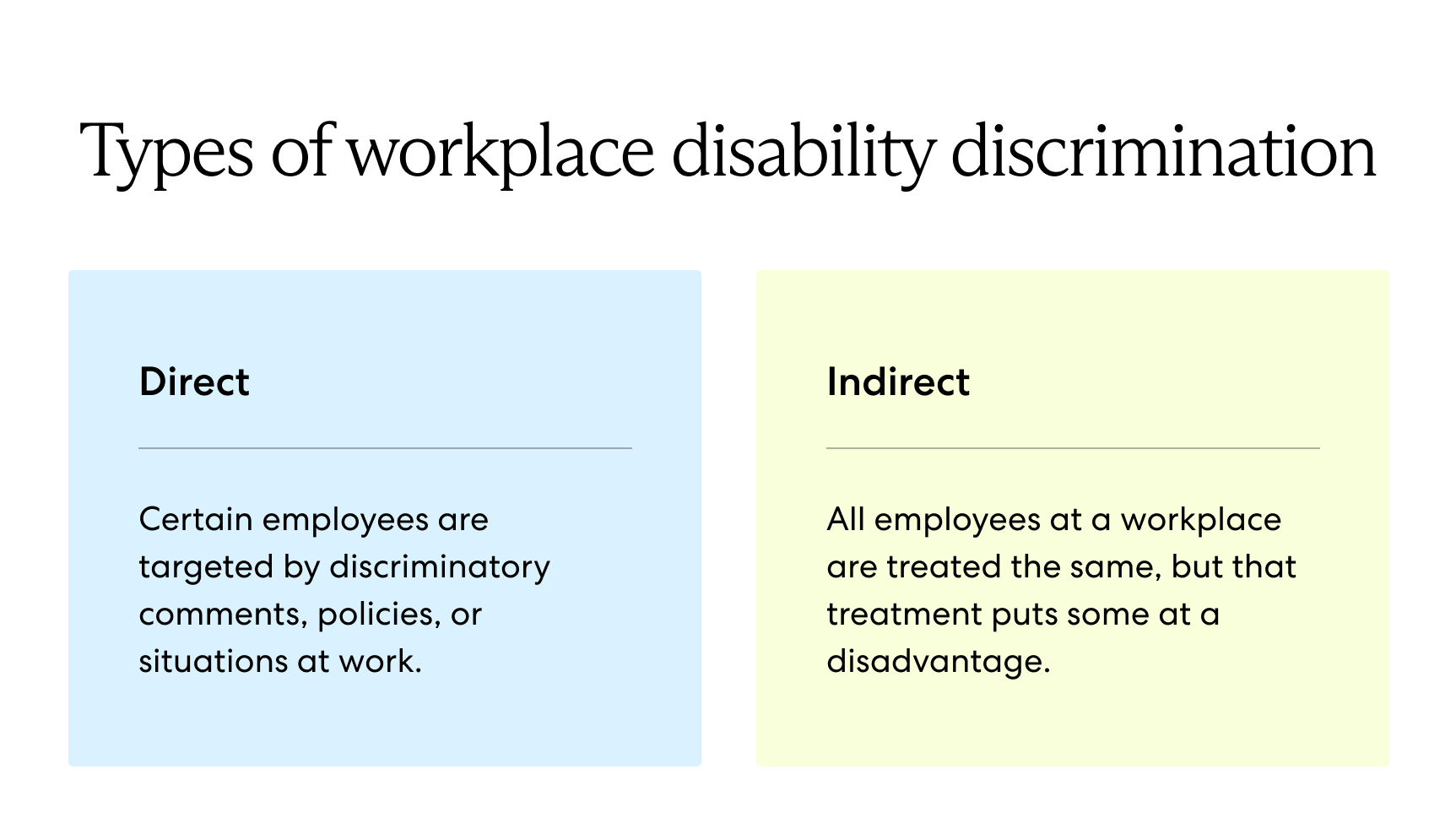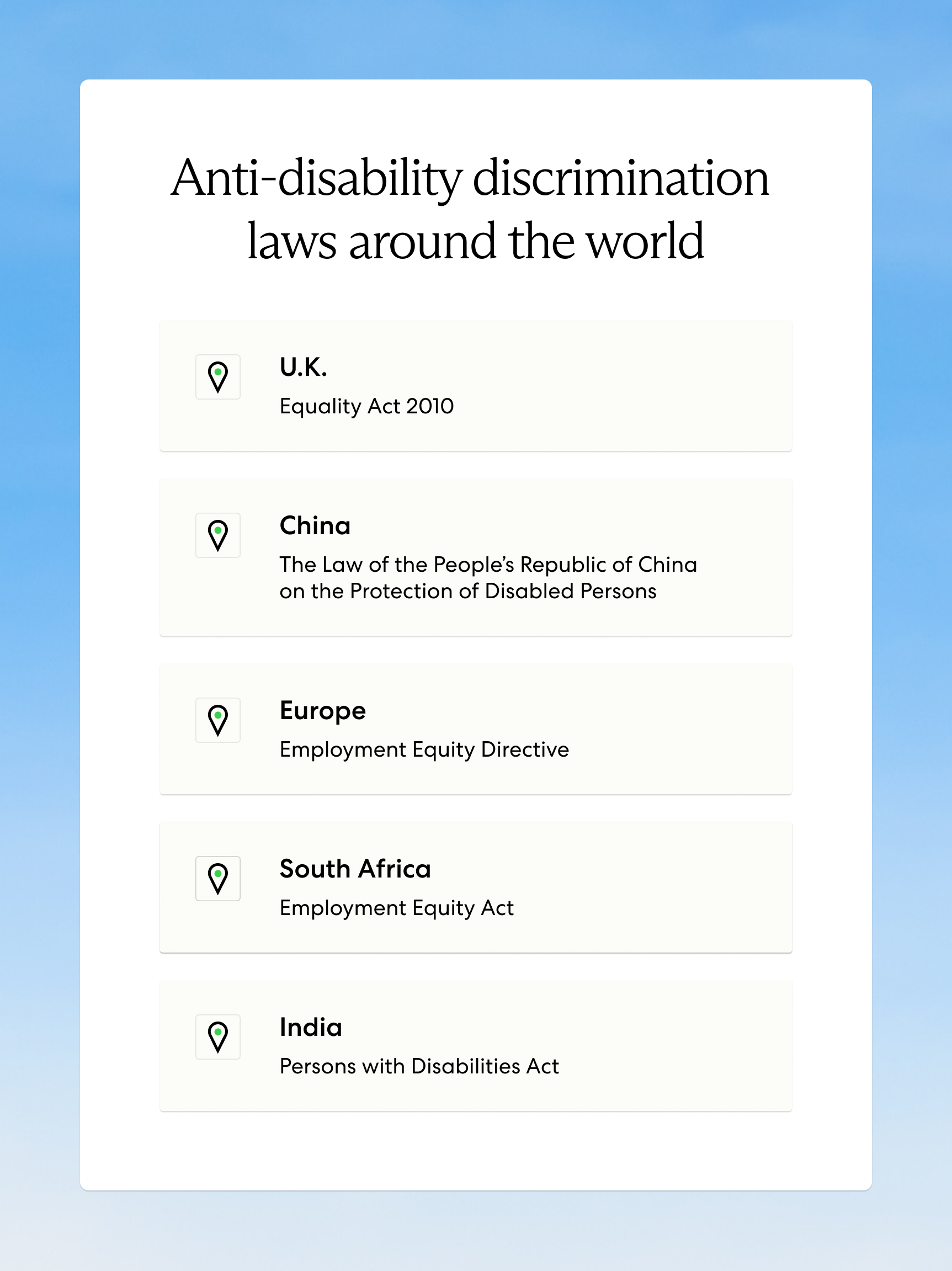Disability in the workplace is common, with an estimated 1.3 billion people worldwide—or about 16% of the global population—living with a disability. Unfortunately, discrimination against people with disabilities in the workplace is also common.
According to the U.S. Department of Labor, the employment rate for working-age people with disabilities was 38% in 2024, while it was 75% for non-disabled people. Despite these employment rates for people with disabilities trending upward over the years, people without disabilities are still almost twice as likely to land jobs than people with disabilities—a stark disparity in today’s labor market.
Employees with disabilities should know their rights and how to escalate their concerns; employers should be prepared to handle notices of discrimination quickly and effectively.
We’ve put together an overview of some regulations regarding disability in the workplace.
What is a disability?
A disability is a physical or mental condition that affects a person’s ability to perform daily activities and interact with their environment. The Americans with Disabilities Act (ADA) outlines protections for qualified individuals with disabilities in the United States. Though the definition of disability varies by country, many nations follow similar guidelines to protect the rights of those in the workforce.
For example, under the ADA, the term “disability” refers to anyone with a physical or mental impairment that substantially limits one or more major life activities, anyone with a record of such an impairment, or anyone regarded as having such an impairment.
This definition includes both visible and invisible disabilities, including chronic health conditions, sensory impairments, mobility limitations, and neurodivergent conditions. Global organizations like the World Health Organization (WHO) recognize disability as part of human diversity, emphasizing that workplace barriers often stem from environmental and social factors rather than the disability itself.
What is disability discrimination in the workplace?

Disability discrimination occurs when an employee faces unfair treatment due to their disability, perceived disability, or association with someone who has a disability.
Workplace discrimination takes two main forms:
Direct discrimination happens when a manager or peer exhibits outright prejudice or unfair behavior toward an employee who has a disability. Examples include outright comments, work policies that target certain employees with disabilities, and/or smaller interactions that build a culture of discomfort at work.
Indirect discrimination happens when all employees are treated the same, yet the treatment results in an inherent disadvantage for employees with disabilities. For example, indirect discrimination might occur when a company enforces a strict attendance policy without considering accommodations for employees with chronic health conditions.
Legal protection against discrimination
Many countries have laws protecting employees with disabilities from workplace discrimination. These laws often require employers to provide reasonable accommodations and ensure equal opportunities.
In the U.S., the ADA protects qualified employees with disabilities. Although the ADA doesn’t apply to private employers with fewer than 15 employees, all employers, regardless of size, may also be subject to state and local employment laws.
What are examples of disability discrimination in the workplace?
Some common examples of workplace disability discrimination may include:
- Denying promotions or opportunities to employees with disabilities
- Refusing to provide accommodations like wheelchair ramps or screen readers
- Making negative comments or remarks toward employees with disabilities
- Asking applicants for their medical history or about their disabilities
- Demoting an employee after they become disabled
- Withholding promotions because of a family member’s disability
- Letting bias against people with disabilities impact hiring decisions
- Harassing employees with disabilities
How to handle disability discrimination in the workplace
Discrimination in the workplace can be hurtful, uncomfortable, and challenging to address. However, tackling the situation head-on can help change the workplace for the better.
According to long-time disability rights activist Judy Heumann, “Change doesn’t happen overnight. It necessitates the ability to articulate the problems and the solutions you believe should be implemented. It requires the ability to articulate the impact of the discrimination, and the effect of your proposed changes.”
Here are some ways business leaders and employees can better handle disability discrimination in the workplace:
For Business Leaders
When business leaders spot discrimination in their workplace, they should work with their counsel and Human Resources to take immediate action to address and put a stop to it. A few ways employers can address discrimination include:
- Establish a formal complaint process. Create a safe and effective reporting process for employees who experience or witness disability discrimination in the workplace.
- Provide reasonable accommodations. Make employees feel valued and cared for by providing the accommodations they need to succeed. Digital tools like Zoom’s live transcription feature enable greater participation for employees with hearing impairments in remote meetings.
- Take swift action. If an employee reports discrimination in the workplace, take immediate action to ensure the issue is resolved.
- Conduct sensitivity training. In situations when discrimination occurs, use it as a learning experience to train employees about what is incorrect and inappropriate behavior.
It is imperative to discuss any actions taken with counsel and Human Resources.
For Employees
Employees who face workplace discrimination have several options for addressing their concerns.
- Understanding legal rights. Most countries provide legal protections for employees with disabilities. Understanding these protections is an essential first step in addressing workplace discrimination.
- Internal resolution process. The first step is often to contact the organization’s Human Resources department. HR professionals can document concerns, investigate claims, and implement necessary workplace changes.
- Filing formal complaints. When internal channels prove insufficient, employees can file formal complaints through appropriate government agencies. These might include national labor boards, equal opportunity commissions (such as the Equal Employment Opportunity Commission in the U.S.), or local administrative bodies that oversee workplace discrimination cases.
- Documentation and support. Throughout the process, employees should:
- Maintain detailed records of incidents
- Document all communication with employers
- Seek support from disability advocacy organizations
- Consider consulting with employment law specialists
Global protections for disabled workers

Disability protections vary worldwide, but most countries have laws protecting individuals with disabilities. When managing a remote international workforce, a global compliance partner can help ensure the company complies with all applicable regulations.
Europe
The European Union (which includes Belgium, Denmark, France, Germany, Greece, Ireland, Spain, and Sweden, among other countries) provides disability protections through regulations. For example, as part of the EU’s labor laws, the Employment Equality Directive prohibits workplace discrimination of employees based on disability and other factors. It also requires employers to provide reasonable accommodations for employees with disabilities.
For example, if a software developer in France develops a visual impairment, their employer must provide screen-reading software and adjust their workstation setup. The directive ensures these accommodations are provided across all EU member states.
China
Citizens with disabilities in China are protected under the Law of the People’s Republic of China on the Protection of Disabled Persons. These laws aim to ensure that disabled people can live life in the same way as people without disabilities.
The Law of the People’s Republic of China on the Protection of Disabled Persons prohibits discrimination against people with disabilities who are trying to gain or sustain employment. To encourage the hiring of disabled people, the law also requires some employers to maintain a certain minimum percentage of disabled employees in their workforce.
As an example, when a manufacturing company in China employs workers with disabilities, they receive tax incentives and financial assistance to provide technical training. However, many companies choose to pay penalties rather than meet quota requirements.
The United Kingdom
In the United Kingdom, people are protected under the Equality Act 2010. They qualify if they have a mental or physical condition that substantially affects their ability to perform day-to-day activities and will last or is likely to last more than one year.
The Equality Act 2010 prohibits discrimination against prospective or current employees with disabilities and also requires businesses to make reasonable accommodations for these employees if they are placed at a substantial disadvantage due to their disability.
An example scenario is when an employee develops a chronic condition that affects their mobility. In that case, the employer must consider flexible working hours to avoid rush-hour travel and modify the workplace layout to ensure accessibility.
South Africa
The Employment Equity Act in South Africa aims to protect employees on the basis of any discrimination they may face, including disability-based discrimination.
The Employment Equity Act aims to protect marginalized groups by prohibiting discrimination against them and implementing affirmative action programs. This act does not apply to the South African National Defense Force, National Intelligence Agency, or South African Secret Services.
A real-world example is Woolworths South Africa, which has implemented inclusive hiring practices and workplace accommodations. These have improved its BBBEE scorecard ratings and enhanced its eligibility for government contracts.
India
In India, employees are protected by the Persons With Disabilities (Equal Opportunities, Protection of Rights and Full Participation) Act. Disabilities under this act include physical disabilities like blindness or low vision and impaired hearing or deafness, intellectual disabilities like autism, mental illness, and disabilities caused by certain blood diseases or chronic neurological conditions like Parkinson’s disease.
India’s Persons With Disabilities Act ensures that jobs suitable for people with disabilities are prioritized for them. Promotions cannot be denied on the grounds of disability, and employees who become disabled while working cannot be demoted. Also, some public sector employers are required to employ people with disabilities as 5% or more of their workforce.
For example, if an employee in an Indian government office develops a disability, the law ensures that they cannot be demoted and must be provided reasonable accommodations to continue working effectively.
Advocate for employees
Employers must actively prevent discrimination in all of its forms—not only because it’s the right thing to do but because not doing so can result in a lawsuit.
“Employers need to strengthen their internal complaint systems by moving away from a compliance and liability avoidance model to one that proactively addresses and prevents discrimination and retaliation,” said Jenny R. Yang and Jane Liu at the Economic Policy Institute as part of their key solutions to confront power and information asymmetries.
Organizations looking to hire a dispersed workforce, should also educate themselves about the labor laws—including disability discrimination laws—that protect employees in different locales. Velocity Global helps businesses navigate these laws and hire and manage their teams.
Contact us today to see how we can help.
Legal Disclaimer: The information available in this guide does not, and is not intended to, constitute legal advice and is for general informational purposes only.
You should contact your attorney to obtain legal advice with respect to any particular legal matter. Only your individual attorney can provide assurances that the information contained in this guide – and your interpretation of it – is applicable or appropriate to your particular situation. All liability with respect to actions taken or not taken based on the information in this guide are hereby expressly disclaimed. The content on this guide is provided “as is” and no representations are made that the content is error-free.
Topic:
Employee Benefits



